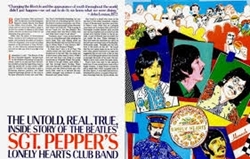- Register
- Log in to Tune-In
- Wishlist (0)
-
Shopping cart
(0)
You have no items in your shopping cart.
From The Vault: THE UNTOLD, REAL,TRUE, INSIDE STORY OF THE BEATLES' SGT ...

Between November 1966 and March 1967 the Beatles recorded Sergeant Pepper’s Lonely Hearts Club Band at the Abbey Road studios. This album, which sold one and a half million copies in its first two weeks of release in the United States, became an electronic bible for the emerging drug generation, then the editor of International Times, London’s first underground newspaper, and currently the editor of London’s Time Out magazine, went to the recording sessions at the invitation of Paul McCartney. In the following behind-the-scenes account he tells you what it was like to be there.
I remember it well. “The Return of the Son of Monster Magnet,” the last track on the Mothers of Invention’s Freak Out album, came to an end and Paul McCartney strolled across his huge living room to take the record off. In one corner a BBC color-TV monitor was mistimed to give a flickering abstract pattern; two René Magritte paintings glowed on the wall in the pale afternoon winter sun; and Martha, Paul’s Old English sheepdog, lay content in front of a crackling log fire. I sat by the French windows enjoying a cup of tea. Paul returned and picked up the conversation where we’d left off. “This is going to be our Freak Out. Not like Zappa’s. But when people hear this they’ll really stop and think about what it’s all about!”
“Fantastic, man!” I said, in that dull flat voice you sometimes get after smoking too much dope. Paul was talking about an album the Beatles had just started recording at Abbey Road. It was January 1967. The album was Sergeant Pepper.
In those days I saw a lot of Paul. The London scene was very small, and if you smoked pot in the mid ’60s, you easily got to know every other head in town. When I first met him, Paul was living in a large townhouse in Wimpole Street, the parental home of his girlfriend, Jane Asher. I met him through Jane’s brother, Peter, who was then still a member of Peter and Gordon and also lived at home and who, much later, went on to become the successful manager and producer of Linda Ronstadt and James Taylor.
Paul lived in a small attic room on the top floor of the Asher household, originally part of the servants’ quarters, next door to Peter’s room. Peter had an L-shaped room done out in modern style with lots of Norwegian wooden shelves, gold records and various trophies and awards from his career with Gordon Waller in the hit parade. A pair of Brenell tape recorders sat just inside the door. These belonged to Paul and were the machines on which he devised and recorded many of the Beatles’ backwards tapes. “BreneÜs are the best even if the knobs do fall off.” He found that his own name came out as Ian Iachimoe when played backward on tape and suggested that we all write to him as that so he could distinguish letters from friends in amongst the sacks of fan mail. He published a short story under the same name.
Source: hightimes.com
